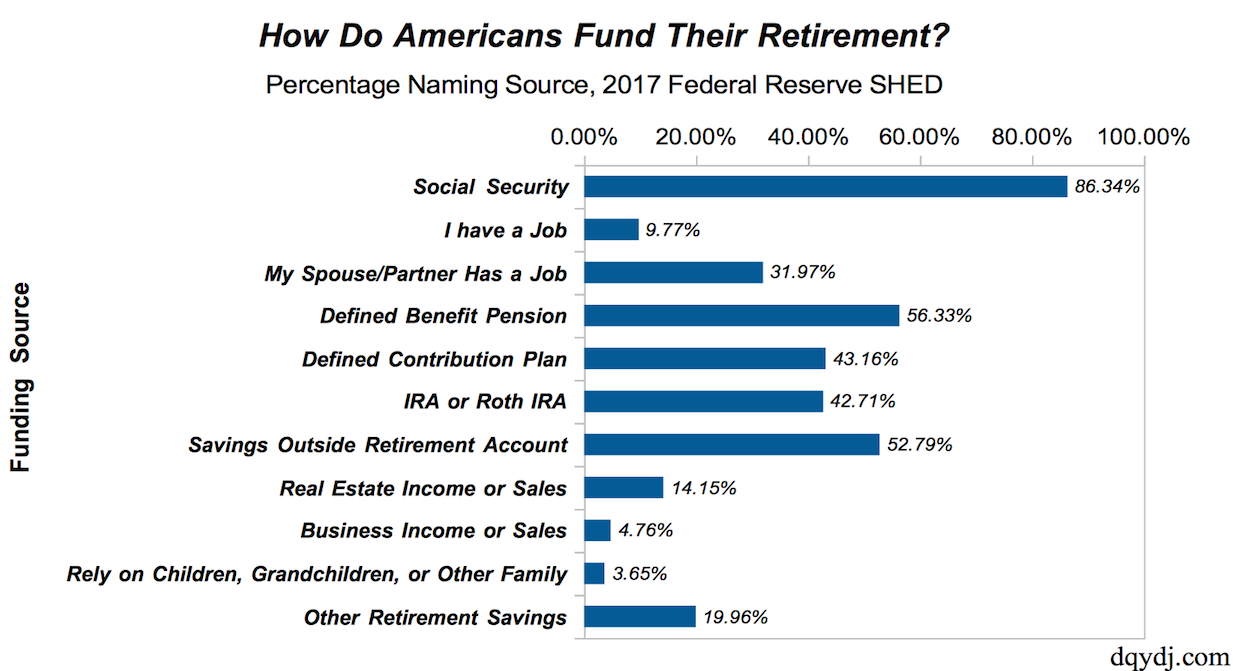
In this post we use 2017 Survey of Household Economics and Decisionmaking microdata to see how do Americans pay for retirement, and also look at what is retirement.
Hopefully this data is useful for your own retirement planning!
How Do Americans Pay For Retirement?
A SHED series of questions enumerated retirement funding sources and asked people who self-classified as retired if they utilize them.
As you can see, sources vary quite a bit - but there are some interesting threads in the data.
Note that 'My Spouse/Partner Has a Job' doesn't use the same base. Only retirees with spouses or partners were asked about that funding source.
As you can see, for current retirees defined benefit pensions are the most common funding source. That's both Social Security as well as other funds of the same classification. Of course, outside of Social Security it's also a rarer benefit nowadays.
As for defined contribution plans (401(k)s, 403(b)s, etc.) only 43.16% of current retirees are using them to fund retirement. IRAs clocked in at 42.71% utilization. 58.1% of retirees reported using either IRAs or defined contribution plans, higher than non-Social Security defined benefit plans.
The major funding source not well captured is downsized homes or other capture of primary home equity. Some respondents may have answered in the real estate category, but primary residences aren't split out. (Here's the guidebook if you'd like to see more, search K10_h).
How Many Americans Fund Retirement with Only Social Security?
Unsurprisingly, Social Security is the funding source most used by American retirees. Some self-classified American retirees were still working, had spouses working, or were not yet of age but still 86.34% of (claimed) retirees collect.
We were curious, however. How many Americans are funding retirement with only Social Security?
Social Security is supposed to be a supplemental program, but we know this safety net is sometimes the only source in place.
Here's how many retirees reported funding retirement with only Social Security or a combination of Social Security and family help alone.
| Number | Percentage of Retirees | |
| Only social security | 7,656,844 | 11.47% |
| Social Security or Family Help | 8,631,396 | 12.94% |
The Social Security Administration agrees on the primary funding source bit. To that end, they delved into the topic with this fact sheet.
From their statistics:
- 9/10 Americans 65+ collect Social Security
- 1/3 of all retiree income is Social Security
As for treating Social Security as a primary income source, they note:
"Among elderly Social Security beneficiaries, 23% of married couples and about 43% of unmarried persons rely on Social Security for 90% or more of their income."
What is Retirement?
Very interestingly, the survey also asks retirees about three controversial sources of income.
Americans who classified as retired might be paying for their retirement through a job, a spouse's/partner's job, or even a business. As a bonus, it also asks broadly about real estate.
Popular blogger Mr. Money Mustache first discussed the "Internet Retirement Police" back in 2013 (after a spark by Jacob of Early Retirement Extreme). He noted that the "Internet Retirement Police" discount people being retired when retirees have certain funding sources.
As the scenario went, here's a theoretical quote:
"It says right in the blog that he does construction work. Also he manages his own rental houses. And has a blog. That doesn’t sound like retirement to me.”
We here on DQYDJ discussed the definition of retirement in back in April of that year.
The Federal Reserve Branch of the 'Retirement Police'
Inadvertently, the Federal Reserve has weighed in on the topic. There are two classifications for 'retired' in the survey - the Fed classified a respondent as a retiree or the respondent classified him or herself.
49.3 million adults are of the former type while 66.7 million fit the latter - and the category the Federal Reserve uses is "Not working - retired".
Here's where the two definitions differ:
| Retiree Funding Source | Classified by Fed | Percentage of Retiree Type | Classify Self | Percentage of Retiree Type |
| With Job | 894,805 | 1.82% | 6,521,079 | 9.77% |
| Number with Job or Spouse Job | 7,903,007 | 16.04% | 17,651,295 | 26.45% |
| Number with Job, Spouse Job, or Business | 8,946,757 | 18.16% | 18,963,480 | 28.42% |
| Number with Job, Spouse/Partner Job, Business, Real Estate Income or Sale | 13,833,958 | 28.08% | 24,556,606 | 36.80% |
Does Retirement Classification Matter?
For precision and policy? Yes, but not for opinion.
It's obvious that a large number of Americans don't hew to official measurements of retirement. Almost 10 million extra Americans consider themselves retired while having a job, a partner with a job, or a business, versus the Federal Reserve's classification.
Retirement categorization is a tricky thing. 26.2% of self-classified retirees don't fit the Fed's mold.
Want to read more? We've also looked at American retirement savings and retirement savings by age.

